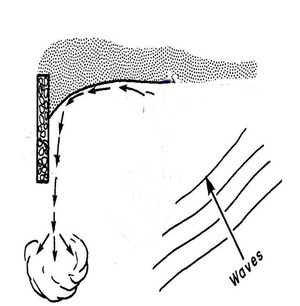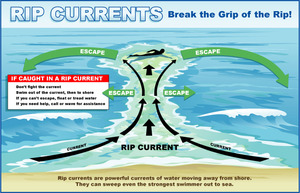Understanding Rip Currents
Summer is a favourite time to enjoy the lake. But too frequently, summer fun can be jarred by a tragic drowning, likely caused by a Rip Current. The Coastal Centre is helping to promote the month of June as “Rip Current Awareness month.” Getting the word out before the summer solstice will maybe lead to a tragedy-free summer.
A rip current is a narrow, powerful current of water running perpendicular to the beach, out into the lake. Rip currents occur in a low spot in a sandbar or near a structure such as a pier or jetty and a narrow band of fast moving water heading offshore. People often associate rip currents channel currents that can sweep them from shore with oceans. However, they happen on the Great Lakes as well, and have claimed numerous lives over the years.

Diagram showing how oncoming waves can generate currents along the shore,
and then develop a rip current where there is an obstruction,like a pier, groyne or jetty.

Source: Michigan Sea Grant
Under most lake conditions thecurrent speeds are relatively slow. However, under certain wave and beach profile conditions the speeds can quickly increase to become dangerous to anyone entering the surf. The strength and speed of a rip current will likely increase as wave height increases. They are most likely to be dangerous during high surf (big wave) conditions.
Man-Made Structures
Rip currents may occur at fixed locations such as groynes, jetties, piers, or other man-made structures where water can be funneled out to the lake in a narrow channel. In coastal areas with structures, a rip current may result when currents running parallel to the shore are deflected offshore by the structure. As waves approach the shoreline, they usually break at an angle, generating a longshore current that flows parallel (along) the beach. When the longshore current (moving along the shore) encounters coastal structure (such as a groyne, jetty, or pier) it is deflected in an offshore direction. This offshore-directed flow of water is called a rip current.
What to Do
- Watch this video
- If you get caught up in a rip current, it's crucial that you keep your wits about you. Your first instinct may be to swim against the current, back to shallow waters. In most cases, even if you're a strong swimmer, this will only wear you out. The current is too strong to fight head-on.
Instead, swim sideways, parallel to the beach. This will get you out of the narrow outward current, so you can swim back in with the waves helping you along. If it's too hard to swim sideways while you're being dragged through the water, just wait until the current carries you past the sandbar. The water will be much calmer there, and you can get clear of the rip current before heading back in.
- Knowing how to deal with rip currents makes for smart swimming. If you see someone in trouble, get help from a lifeguard. If a lifeguard is not available, have someone call 9-1-1. Throw the rip current victim something that floats and yell instructions on how to escape. Remember, many people drown while trying to save someone else from a rip current.
- Share this information with family and friends. Let’s put an end to summer tragedies.
In Deep
Water levels continue to climb on Lake Huron. After a low evaporation, high precipitation Fall/Winter/Spring, levels continue on their seasonal rise, with another 5-10 centimetres expected this month. The U.S. Army Corps of Engineers projects an approximate 25 cm. increase over the next six months. This would place levels on Lake Huron about 30 cm. below their record highs experienced in 1985-86.
This may come as a shock to anyone who may have purchased a cottage along the shoreline after 1999. From that year until January 2013, we experienced an extended period of low lake levels. Current levels are more in line with what we experienced in the 1970s, 80s and 90s.
Recent climate models suggest that lake levels will continue to shift between highs and lows, within the historical recorded range, possibly with greater frequency. So, current levels are not unusual, but they stand in sharp contrast to the last decade and a half of low levels.
Check on Water Level Gauges here
Next to Godliness
June 24 commemorates Saint Jean Baptiste, the patron saint of Poutine. You can be a saint by donating to the Coastal Centre. Donate to the Centre and sooth your Tourtiered soul.
